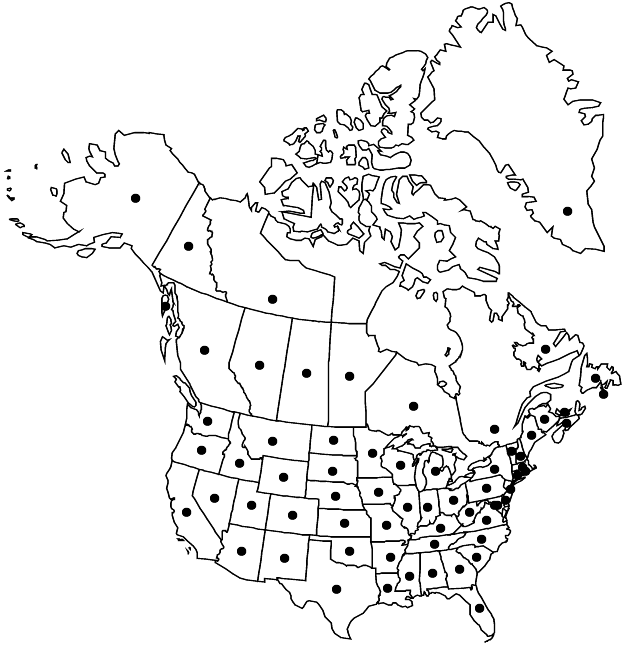Difference between revisions of "Stellaria media"
Hist. Pl. Dauphiné 3: 615. 1789.
FNA>Volume Importer |
FNA>Volume Importer |
(No difference)
| |
Revision as of 20:07, 24 September 2019
Plants annual or winter annual, green, with slender taproot. Stems decumbent or ascending, diffusely branched, 4-sided, 5–40 cm, with single line of hairs along each internode. Leaves petiolate (proximal) or ± sessile (distal); blade usually green, ovate to broadly elliptic, 0.5–4 cm × 2–20 mm, base round to cuneate, margins entire, apex acute or shortly acuminate, ± glabrous or ciliate at base. Inflorescences terminal, 5–many-flowered cymes; bracts ovate and shortly acuminate to lanceolate-acute, 1–40 mm, herbaceous. Pedicels ascending, usually straight, deflexed at base in fruit, 3–40 mm, usually with line of hairs. Flowers 2–5 mm diam.; sepals 5, with obscure midrib, ovate-lanceolate, 4.5–5(–6) mm, margins narrow, scarious, apex obtuse, usually glandular-hairy; petals absent or 5, 1–4 mm, shorter than to equaling sepals; stamens 3–5(–8); anthers red-violet; styles 3, outwardly curved, becoming curled, 0.5–1 mm. Capsules green to straw colored, ovoid-oblong, 3–5 mm, somewhat longer than sepals, apex obtuse, opening by 6 valves; carpophore absent. Seeds reddish brown, broadly reniform to round, 0.9–1.3 mm diam., with obtuse, round, or flat-topped (broader than tall) tubercles. 2n = 40, 42, 44.
Phenology: Flowering year-round where climatic conditions permit.
Habitat: Cultivated ground, waste places, open woodlands
Elevation: 0-2500 m
Distribution

Greenland, St. Pierre and Miquelon, Alta., B.C., Man., N.B., Nfld. and Labr., N.W.T., N.S., Ont., P.E.I., Que., Sask., Yukon, Ala., Alaska, Ariz., Ark., Calif., Colo., Conn., Del., D.C., Fla., Ga., Idaho, Ill., Ind., Iowa, Kans., Ky., La., Maine, Md., Mass., Mich., Minn., Miss., Mo., Mont., Nebr., Nev., N.H., N.J., N.Mex., N.Y., N.C., N.Dak., Ohio, Okla., Oreg., Pa., R.I., S.C., S.Dak., Tenn., Tex., Utah, Vt., Va., Wash., W.Va., Wis., Wyo., Europe.
Discussion
Stellaria media, now a cosmopolitan weed, is a very polymorphic species, varying in size, habit, pubescence, petal length, stamen number, and seed size and surface detail.
The Stellaria media complex consists of three very similar and closely related species, S. media, S. neglecta, and S. pallida. They can almost always be distinguished by the characters given in the key, but in a few doubtful cases a chromosome count is desirable for positive identification. The problem arises from the considerable phenotypic variation which is displayed by S. media, and to a lesser extent by S. pallida. There is no evidence for gene exchange between these species. Stellaria pallida is autogamous and sometimes cleistogamous; S. media is both autogamous and occasionally cross-pollinated by flies; S. neglecta is usually cross-pollinated by flies but is self-compatible.